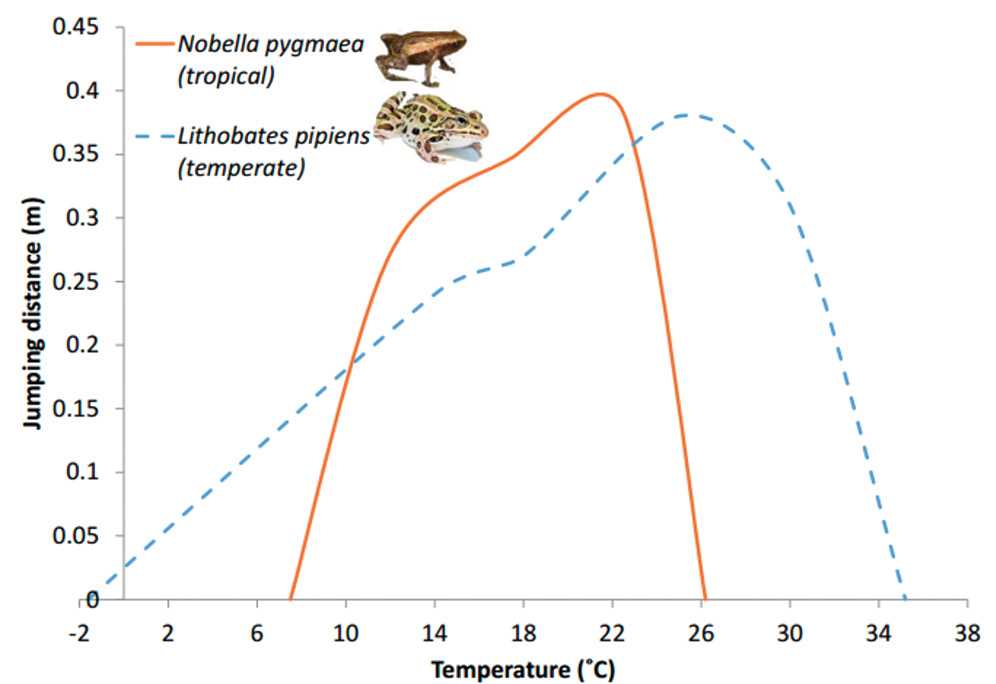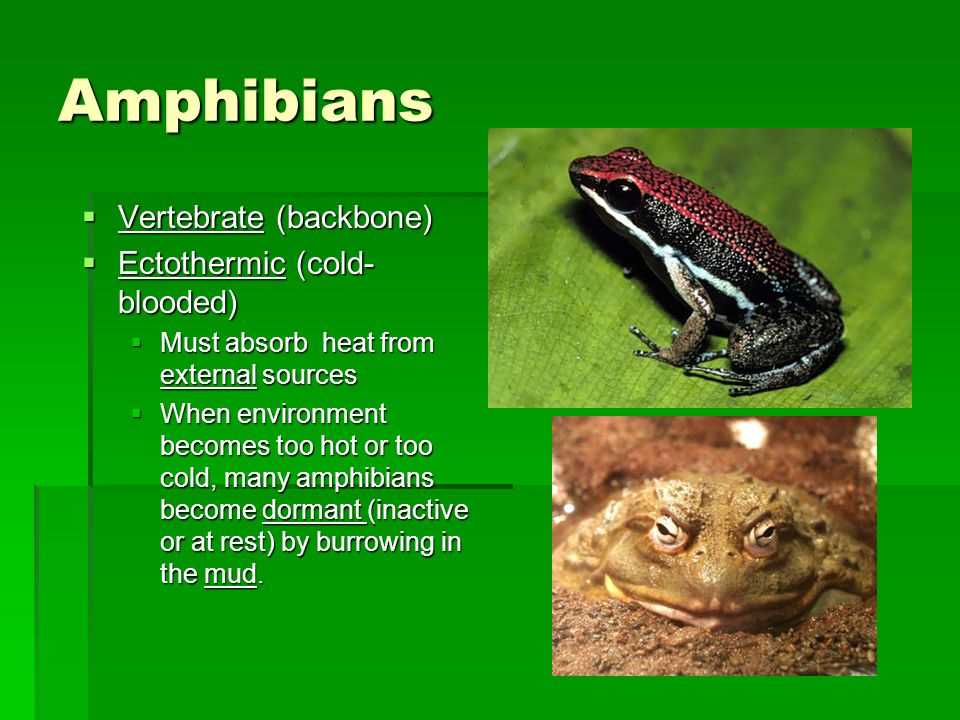
Ectothermic animals, or “cold-blooded” animals, such as frogs, have a body temperature that fluctuates with the temperature of their environment. This means that frogs cannot maintain a constant internal body temperature like warm-blooded animals can.
On the other hand, being ectothermic also means that frogs are more susceptible to changes in their environment. Their activity levels and metabolism are greatly influenced by temperature, which can impact their ability to hunt, reproduce, and survive in extreme conditions.
In order to regulate their body temperature, frogs employ various behavioral and physiological strategies. They often bask in the sun to absorb heat or seek shade to cool down. They may also burrow into the ground or retreat to bodies of water to regulate their body temperature.
Overall, frogs’ ectothermic nature is a fascinating aspect of their biology. It highlights the incredible diversity of adaptations in the animal kingdom and reminds us of the intricate ways in which organisms have evolved to survive in their environments.
What Are Ectothermic Animals?

Ectothermic animals, including frogs, are organisms that rely on external sources of heat to regulate their body temperature. Unlike endothermic animals, such as mammals and birds, ectotherms do not generate their own body heat internally. Instead, they depend on the environment to provide the necessary warmth or coolness to maintain their internal temperature.
Ectothermic animals have various strategies to regulate their body temperature. They can bask in the sun to absorb heat or seek shade to cool down. They may also adjust their behavior, such as burrowing underground or moving to different areas, to find suitable temperature conditions. Additionally, ectotherms can control their metabolic rate by slowing it down or speeding it up in response to temperature changes.
Being ectothermic has both advantages and disadvantages for animals like frogs. One advantage is energy conservation. Because ectotherms do not need a constant supply of energy to maintain their body temperature, they often have lower metabolic rates and can survive on less food compared to endothermic animals. This can be particularly beneficial in environments with limited resources.
However, ectothermic animals are highly reliant on their surroundings for thermoregulation. They are more susceptible to temperature fluctuations and may need to adapt their behavior or habitat selection to survive extreme conditions. For example, frogs may hibernate during cold winters or aestivate during hot dry seasons to avoid unfavorable temperatures.
| Advantages of Ectothermy | Disadvantages of Ectothermy |
|---|---|
| Energy conservation | Reliance on external heat sources |
| Lower metabolic rates | Temperature fluctuations |
| Ability to survive on less food | Potential habitat limitations |
Frogs are ectothermic animals: Definition and examples
Examples of ectothermic animals include reptiles, amphibians, fish, and invertebrates such as insects and crustaceans. These animals possess various adaptations that allow them to survive and thrive in different environments and climates.
Characteristics of ectothermic animals:

Ectothermic animals have several key characteristics that distinguish them from endothermic animals:
- They have a lower metabolic rate compared to endothermic animals, which means they require less energy to survive.
- They rely on behavioral adaptations, such as basking in the sun or seeking shade, to regulate their body temperature.
Importance of ectothermy for frogs:
The ectothermic nature of frogs is crucial to their survival and lifestyle. As amphibians, frogs undergo metamorphosis from aquatic tadpoles to terrestrial adults. During this process, their reliance on external heat sources increases.
Frogs use their environment to regulate their body temperature. They bask in the sun to warm up and seek shade or water to cool down. This behavior allows them to optimize their metabolic processes and energy expenditure.
Furthermore, the ability to adjust their body temperature according to the surroundings enables frogs to inhabit a wide range of habitats, from tropical rainforests to arid deserts. This adaptability is advantageous for their survival and reproductive success.
The Ectothermic Nature of Frogs

For frogs, this means that their body temperature is largely determined by the temperature of their environment. They do not have the ability to regulate their body temperature internally like warm-blooded animals do. Instead, they adjust their behavior and physiology to adapt to the temperature changes in their surroundings.
One of the ways frogs regulate their body temperature is through their behavior. They will move to different locations or habitats within their environment to find optimal temperatures. For example, on a hot day, frogs may seek out shady areas or burrow into the ground to avoid overheating. On cooler days, they may bask in the sun or move to warmer areas to raise their body temperature.
Frogs also have adaptations that help them cope with temperature changes. Their skin is thin and permeable, allowing for efficient heat exchange with the environment. They may also use other strategies such as evaporative cooling, where they release moisture from their skin to cool down.
The ectothermic nature of frogs has both advantages and disadvantages. One advantage is that they require less energy to maintain their body temperature compared to endothermic animals. This means that they can survive on limited food resources and have slower metabolic rates. However, being ectothermic also makes frogs more vulnerable to extreme temperature fluctuations. They are highly sensitive to environmental changes, and their survival and reproduction can be greatly impacted by alterations in temperature.
frogs are ectothermic animals that rely on external sources of heat to regulate their body temperature. They do not have the ability to generate their own body heat internally and instead adjust their behavior and physiology to adapt to temperature changes in their surroundings. This ectothermic nature has both advantages and disadvantages for frogs, allowing them to conserve energy but also making them more vulnerable to temperature fluctuations.
Advantages and Disadvantages of Ectothermy in Frogs

Frogs, like other ectothermic animals, rely on external sources of heat to regulate their body temperature. This has both advantages and disadvantages in their survival and daily activities.
One of the main advantages of ectothermy in frogs is energy conservation. As ectotherms, frogs do not need to expend energy to maintain a constant body temperature. Instead, they can rely on their environment to provide the necessary heat. This allows them to conserve energy that would otherwise be used for thermoregulation, which can be beneficial in situations where food resources are scarce.
Another advantage of ectothermy in frogs is their ability to adapt to different environmental conditions. With the ability to adjust their behavior and activity level, frogs can optimize their energy intake and output based on the temperature of their surroundings. This flexibility allows them to survive in a wide range of habitats, from hot and dry deserts to cold and wet rainforests.
However, there are also disadvantages to ectothermy in frogs. One of the main challenges is their dependence on external heat sources. If the temperature drops too low, frogs may become sluggish or even enter a state of hibernation to conserve energy. This can limit their activity and feeding opportunities, especially in colder climates.
| Advantages | Disadvantages |
|---|---|
| Energy conservation | Dependence on external heat sources |
| Ability to adapt to different environments | Vulnerability to temperature fluctuations |
Benefits and Challenges of Being Ectothermic
Being ectothermic, or cold-blooded, offers both benefits and challenges for frogs. One of the major advantages of ectothermy is that frogs do not need to spend energy on regulating their body temperature. Instead, they rely on their environment to provide the heat they need to function optimally. This means that frogs can survive in a wide range of temperatures, from hot tropical climates to cooler temperate regions.
Additionally, the ectothermic nature of frogs allows them to be more efficient in their energy use. Since they do not need to generate heat internally, they require less food to sustain themselves compared to endothermic animals. This is particularly beneficial in environments where food availability may be limited.
However, being ectothermic also poses some challenges for frogs. One of the main challenges is that they are highly dependent on external temperature fluctuations. If the environment becomes too cold, frogs may become sluggish and unable to move or hunt for food. On the other hand, if the environment becomes too hot, frogs may become dehydrated and risk overheating.
To overcome these challenges, frogs have developed various adaptations. For example, they are capable of changing their behavior to regulate their body temperature. They may move to areas with more sunlight to warm up or seek out shade when it gets too hot. Frogs can also absorb heat through their skin or become more active during warmer parts of the day.

I’m Lena Adams—a product of an unconventional upbringing in the African wilderness. My father, a daring explorer of African wildlife, sparked my fascination with reptiles, a passion that intertwined with the tragic loss of my mother during an expedition, leaving an indelible mark on my life. Driven to understand the creatures that captivated my parents, I embarked on my journey, sharing insights about reptiles, frogs, and lizards on my website. Through my explorations and conservation efforts, I honour my family’s legacy while seeking connections—to the creatures, nature, and the mother whose presence I yearn to understand.
